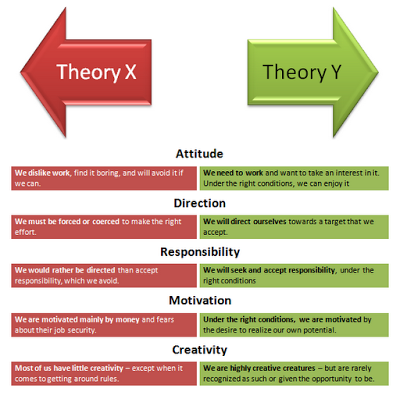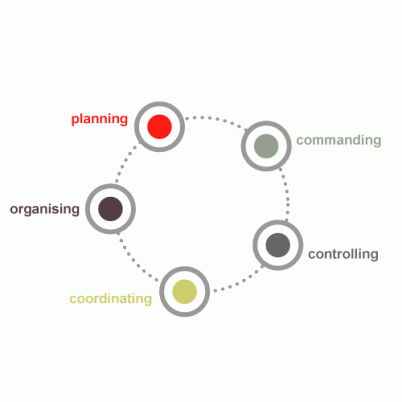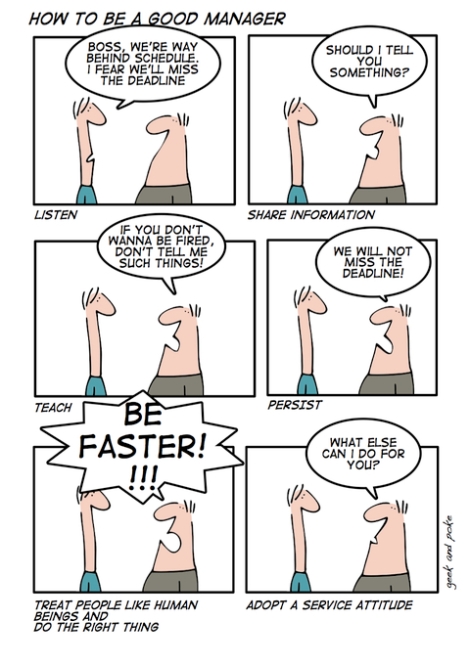It is sometimes hard to demarcate the boundary between leadership and management and people tend to understand them similarly. Leadership is ¨a relationship through which one person influences the behavior or actions of other people¨ (Mullins 2013: 369) whereas Management is regarded as ¨taking place within a structured organizational setting with prescribed roles, directed towards the attainment of aims and objectives, achieved through the efforts of other people and using systems and procedures¨ (Mullins 2013: 421)
Many meanings are available but an easy way to grasp the difference is by comparing them:
(sf.densilporteous.com 2014)
Looking to the past, different definitions, classifications and theories have been applied:
- Fayol established 14 principles, based in authority, discipline, command and centralisation, and 5 elements of management:
(mbaknol.com 2014)
- Later on, Drucker continued the analysis and established the 5 operations of the manager:
(kfknowledgebank.kaplan.co.uk 2014)
- Mintzberg was more focused in the different roles the manager can play, classifying them in 3 types, depending what is managed:
(biggerplate.com 2012)
- McGregor created Theory X and Y to classify managers with regards to the way managers look to their employees:

(nitieim19pomb126.blogspot.co.uk 2012)
Most of the managers have questioned themselves whether they are good manager or not. But, what is a good manager?
(Krigsman 2008)
Roberta Matuso summarizes several characteristics a candidate should have in order to be an excellent manager (Matuso 2014):
- Commitment in the process of becoming a ¨magnetic¨ manager
- Great managers and great listeners
- Terrific managers put the needs of their employees first
- Excellent managers mentor, support and champion their people
- Great managers reward their people for a job well done, giving credit where credit is due
- Smart managers help their people gain the skills they need to be promotable
- The best managers have their employees’ backs
However, the above mentioned topic relates to effective leadership. Indeed, a manager manages time, material, resources, goals, objectives but also people, therefore, additional skills are required in order to succeed. A manager not necessarily will be a leader and vice-versa but ideally the candidate leads the team and manages four different groups of people: subordinates, superiors, customers and colleagues.
Having analysed the evolution of Management concept and taking into consideration that managers aim to be a successful leader, the question is: what personal style should I adopt and what is the most effective approach to manage the subordinates´ work? Personally, I do not think there is a unique style or approach since every team has a different identity, content, targets, interests, worries or reality. Hence, the manager needs to analyse both, every member independently and as a group, and then compare the result with the company´s objectives, enhancing the common aspects and resolving the differences so as the whole unity moves forward towards similar goals and motivations.
It is important to remember that managers should be clear, direct and concise when communicating so subordinates will understand their tasks. This ideal communication is often assumed but not always happens and generates frustration in the subordinates and eventually the manager will realize that the staff is not working as he thinks he had commanded. At this point, I would like to reflect on an exercise experienced during the MBA where I was playing the manager role, classmate 1 was my subordinate and classmate 2 the builder. From an initial 5-pieces Lego structure, I was requested to generate an identical shape by the builder through my subordinate. We were competing with other managers so time was crucial and my team was multi-cultural. I found several obstacles during this activity which can be grouped in 3:
- Communication: different nationalities, none of us English native speakers. Moreover, I was not sure about the number of commands to give every time for my instruction to be efficient and properly understood
- Personal skills: I am a visual person, so it is easy for me to define the structure through images but we were only allowed to use verbal instructions. The Lego pieces had different colours and sizes and connected in several ways (horizontally, vertically, above, below). The subordinate was less used to work under pressure so, as we were reaching the end of the experience, she got confused when listening to the instructions
- Interaction: improving subordinates´ perception by moderating the instruction, proper voice level, limit the number of instructions, repeat as many times as necessary for the subordinate to understand the goals
Personally, if I am the one being led, I would like to be listened, considered, motivated and involved in the company´s activities having a manager able to lead the team efficiently, decisive, assertive and problem solver.
To sum-up, managers willing to become efficient leaders should analyse their teams, being by their side and creating the strategy in accordance with the company´s objectives, taking into consideration there is no general strategy and the most suitable approach depends upon the characteristics of its members.
References
biggerplate.com (2012) Mintzberg’s Managerial Roles [online] available from < http://www.biggerplate.com/mindmaps/1JpRpTtY/mintzberg-s-managerial-roles-160 > [11 June 2014]
Krigsman, M. (2008) How to be a Good Manager [online] available from < http://geekandpoke.typepad.com/geekandpoke/2008/02/how-to-be-a-goo.html > [11 June 2014]
Matuso, R. (2014) How to Become a Great Manager in 2014 and Beyond [online] available from < http://www.forbes.com/sites/robertamatuson/2014/01/02/how-to-become-a-great-manager-in-2014-and-beyond/ > [11 June 2014]
mbaknol.com (2014) Henri Fayol’s Principles of Management [online] available from < http://www.mbaknol.com/management-principles/henri-fayols-principles-of-management/ > [10 June 2014]
Mullins, L. (2013) Management and Organisational behaviour. Harlow: Pearsons
nitieim19pomb126.blogspot.co.uk (2012) Theory X, Theory Y and Theory Z [online] available from < http://nitieim19pomb126.blogspot.co.uk/2012/08/theory-x-theory-y-and-theory-z.html > [11 June 2014]
sf.densilporteous.com (2014) Are you a leader or a manager? [online] available from < http://sf.densilporteous.com/are-you-a-leader-or-a-manager/ > [10 June 2014]





I totally agree with this post. A good example to compliment this post and understand quite easily the difference between leadership and managing we can see it in the book Lord of the Rings . At the council of Elrond, there is an argument about how they should proceed. Frodo Baggins rescues the council from the conflict by taking responsibility for destroying the ring. He sets a direction, but has no idea how to go about it. During the quest, most of the management of the group comes from others – particularly Gandalf and Aragorn. 😉
Borx, thanks for your comment. It is true, although I am not expert with these type of pictures, but the difference between Manager and Leader can be seen and applied in many different scenarios, from the professional to the personal point of view.
I like your references to Matuso 2014. I think that it is very good to aspire to this kind of management style where one actually puts the needs and development of others first. This is important because this is how you get the best and the most from your teams. However, how many managers have you encountered that routinely do this? You mentioned that good managers need to be flexible with respect to different teams and actually I totally agree with you. But I think this is not the only time that you need to be flexible and adapt different managerial styles. For example, in a crisis situation at work I would always become very authoritative and give clear short orders until the crisis has passed. In other situations, I will step back and have the team come up with the solution and I will only be a facilitator to reach the solution making sure that the decision is reached in an agreed time frame (if I agree it is a positive one for the team and the organization). It is important to be flexible with the same team in different situations too.
I really liked your diagrams and videos in this article especially the Mintzberg diagram. Initially, it seems complicated, however what he is summarizing is very simple and a really great diagram for every manager to look at from time to time. I’m going to put a copy on my desk!
Hehe, let me know if you want the copy, as I have some on my desk too 😉
To your question, unfortunately I’ve met very few managers like that, however I want to believe the filed that I worked (Construction) and the country I was working (Qatar) didn’t ease the situation for this to happen. I strongly believe that following these theories and patterns, anyone can become a great leader!
Regarding your behaviour, that’s absolutely right. Actually, there is no right or wrong. Everyone applies his/her model and if that works (and its ethical), its perfectly right. However, being authoritarian can be risky at some point. You have to be careful when and with who.
Thanks for your valuable comments!
L
wonderful LLuis, but i don’t agree with you on every team should be managed differently because if i treat teams differently that will led to injustice and the the teams won’t be motivated because some of them will think that you don’t like them thats why u treat them different,
Mubarak,
That’s absolutely right, no one should be treated differently. And actually this is what I said, maybe there was a misunderstanding. I said that teams should be managed differently, depending on the nature of the group, but I did not say that MEMBERS should be treated differently 😉
I hope this clarifies my point.
Thanks a lot for your comment.
L